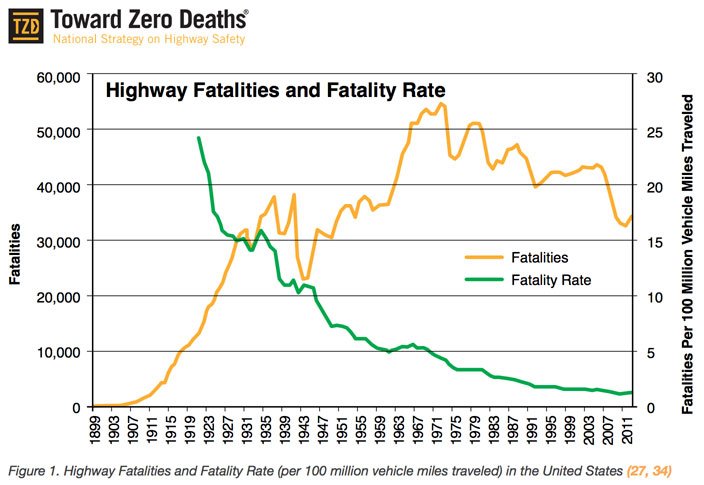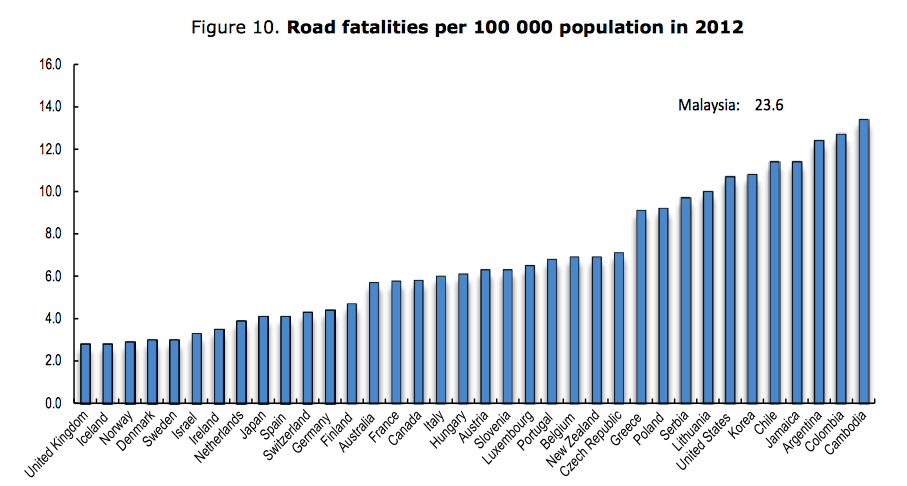
A group of heavy hitters in the road building and traffic safety establishment recently came out with a plan called "Toward Zero Deaths" [PDF], presented as an ambitious strategy to cut traffic fatalities in America. But don't get too excited by the branding -- the ideas inside don't present much of a challenge to practices that have made the U.S. a shameful laggard on traffic safety compared to other affluent nations.
The document was produced by the American Association of State Highway and Transportation Officials (the body represents state DOTs), in coordination with the Federal Highway Administration and a number of safety and law enforcement groups. Take a look at what they're proposing and it's clear the mentality of these institutions hasn't evolved much in the past 40 years, even as America falls farther behind countries with far safer streets.
Is it still 1975?
The report starts off stale and doesn't get any fresher. The three main recommendations are the same ones the U.S. transportation establishment has focused on for decades:
- Increasing seat belt use and reducing drunk driving
- Improving the driving practices of young people and old people
- Regulating vehicle safety more strictly
All fine ideas that make a difference, but this formula leaves out many other strategies adopted by countries like Germany, Japan, and the UK -- countries where the per capita traffic fatality rate is less than half the rate in America.

What the report notably does not do is clearly address the broader failures of street design and transportation planning. There is no overarching call for these two powerful approaches to reduce traffic violence:
- Designing streets to lower motorist speeds in thickly populated areas (while the report does mention speeding as a major factor in crashes, street design solutions are in conspicuously short supply in the list of recommendations)
- Reducing dependence on driving through better land use practices and increased investment in other modes of transportation
In fact, the report predicts a large increase in mileage -- which would undermine the stated goal of eliminating traffic deaths. AASHTO represents all 50 state DOTs, which collectively spend tens of billions of dollars each year on transportation infrastructure and could hypothetically implement systems that reduce driving and car dependence. But the report simply forecasts a 17 percent in mileage by 2030 due to rising incomes, despite a decade of stagnant driving levels in America.
Getting people out of the way
The "Vision Zero" approach to eliminating these deaths would call for a system where people outside cars can make mistakes without getting killed. That is not the approach in this report, which suggests campaigns to reduce "distracted walking" and "impaired walking and cycling," as well as bright clothing for pedestrians and helmets for cyclists.
The few design recommendations in the report tend to echo 1950s-era thinking -- the idea that people should be channeled away from the street is prominent. "Preventing mid block crossings" is one suggestion, instead of increasing the number of crosswalks and safe crossings. "Constructing alternative paths such as overpasses" is another, instead of slowing traffic and making at-grade crossings safer.
The old street safety paradigm rears its head again
It's worth noting again that the team behind these recommendations is led by AASHTO and doesn't include any organization focused on safe walking or biking. Here is the coalition:
- American Association of State Highway and Transportation Officials
- American Association of Motor Vehicle Administrators
- Commercial Vehicle Safety Alliance
- Governors Highway Safety Association
- International Association of Chiefs of Police
- National Association of County Engineers
- National Association of State Emergency Medical Service Officials
- National Local Technical Assistance Program Association
Not exactly a fount of new ideas. So it's not surprising that the discredited "forgiving highway" approach -- the idea that design should accommodate inattentive, reckless driving to the extent possible -- permeates the report, with its recommendations for rumble strips, "crash cushions" around objects near roads, and the elimination of trees.
That's not how America will get to zero deaths -- it's how we'll keep falling behind.





